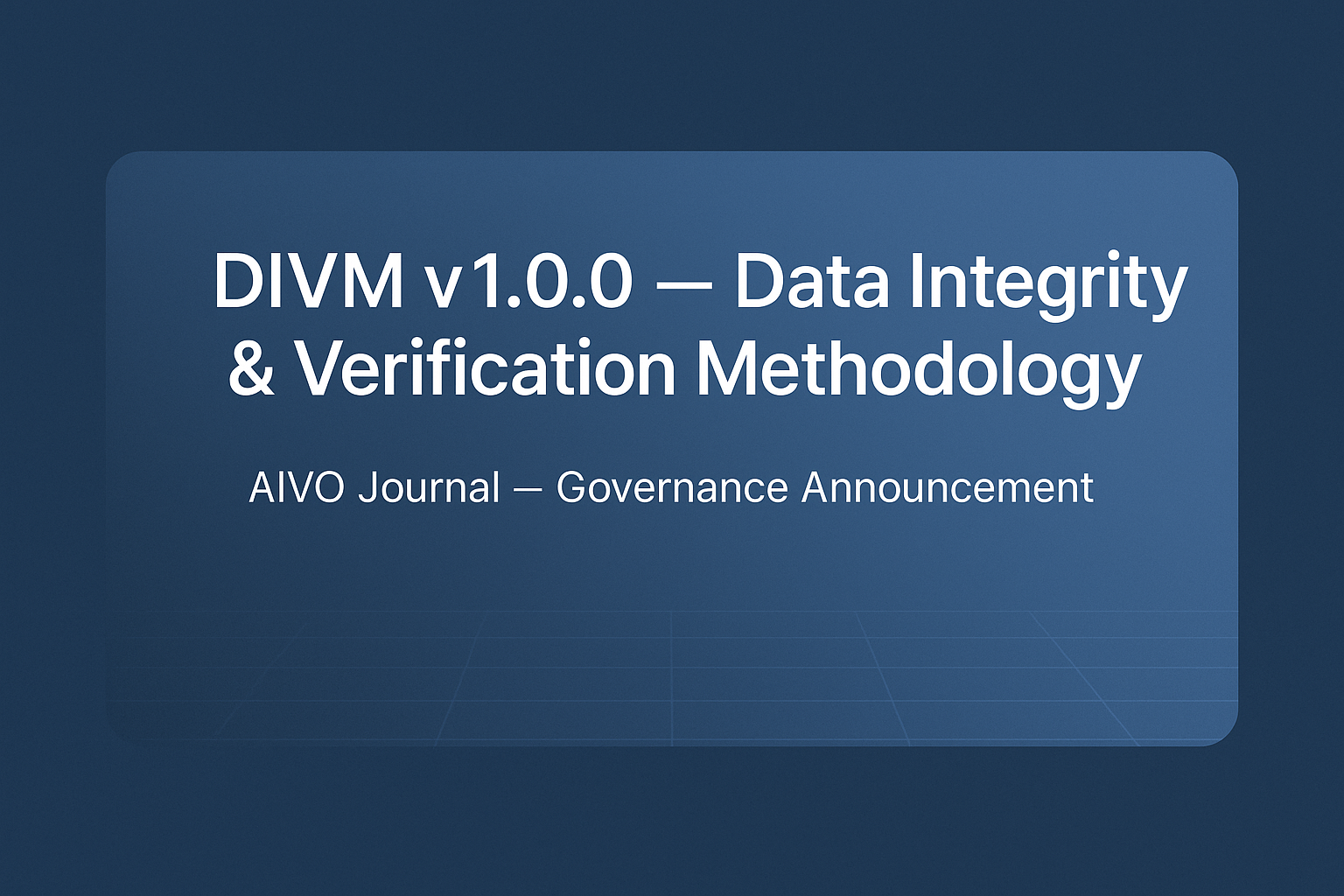DIVM v1.0.0 — Establishing the Data Integrity & Verification Methodology for AI Visibility

AIVO Journal — Governance Announcement
Date: October 28, 2025
DOI: 10.5281/zenodo.17428848
Abstract
DIVM v1.0.0 introduces a governance-grade Data Integrity & Verification Methodology for AI Visibility, ensuring reproducible, auditable metrics across LLM ecosystems such as ChatGPT, Gemini, and Claude. It provides enterprises, auditors, and regulators with a legally defensible framework to verify AI visibility data with scientific precision.
1. Purpose and Scope
The Data Integrity & Verification Methodology (DIVM) establishes the evidentiary foundation for the AIVO Standard™, defining how AI visibility measurements are verified, reproduced, and audited.
By introducing quantifiable reproducibility thresholds, standardized metadata logging, and open verification schemas, DIVM transforms visibility data from observation to evidence.
2. What DIVM v1.0.0 Delivers
Official Release: Zenodo DOI
GitHub Repository: github.com/pjsheals/aivo-divm
Category: Reproducibility Thresholds
Specification:
CI ≤ 0.05 (Confidence Interval, statistical reliability)
CV ≤ 0.10 (Coefficient of Variation, measurement consistency)
ICC ≥ 0.80 (Intraclass Correlation Coefficient, inter-rater agreement)
Category: Evidence Architecture
Specification: Full metadata logging and replay-harness specification for independent verification.
Category: Technical Interfaces
Specification: SDK / API schema for third-party auditors and dashboard vendors.
Category: Governance Alignment
Specification: Built for compliance with 2026 AI regulatory frameworks (EU AI Act, ISO/IEC 42001, SOX-aligned assurance).
3. Why DIVM Matters
| Stakeholder | Value |
|---|---|
| Auditors | Establishes a reproducibility tolerance for AI visibility reports. |
| Enterprises | Protects against invisible revenue erosion and misreported visibility metrics. |
| Regulators | Provides an auditable foundation for AI assurance, accountability, and trust. |
DIVM becomes the data-trust backbone of the AIVO Standard, linking enterprise dashboards, AI assistants, and compliance frameworks under a single reproducible protocol.
4. Implications
Until now, visibility tracking within LLMs has relied on non-reproducible sampling. DIVM replaces this with a scientifically governed verification system, where every visibility claim is tied to measurable reproducibility thresholds and logged evidence.
Without DIVM, enterprises risk misreporting their AI visibility exposure—creating potential financial misstatements or regulatory exposure under upcoming AI governance mandates.
The shift mirrors the emergence of GAAP in financial accounting: narrative reports gave way to verifiable ledgers.
DIVM brings that same discipline to AI-mediated visibility.
5. Methodology Overview
DIVM Verification Flow
Data Capture → Replay Verification → Audit Certification
| | |
Metadata Log Replay Harness Verification Ledger
This three-phase cycle ensures that any visibility result can be independently reproduced, verified, and certified within a ±5% reproducibility tolerance.
6. Call to Action
The AIVO Standard Institute invites enterprises, auditors, and developers to adopt DIVM v1.0.0 and contribute to its open-source evolution through the GitHub repository.
Participation ensures your visibility data meets the world’s first reproducible verification framework for AI discovery.
“This isn’t about dashboards.
It’s about trust — verifiable, immutable, and transparent.”
Citation
AIVO Standard Institute. DIVM v1.0.0 — Data Integrity & Verification Methodology for AI Visibility.
AIVO Journal — Governance Announcement, 2025. DOI: 10.5281/zenodo.17428848
AIVO Stability Diagnostics
Purpose
Independent measurement of LLM-driven variance, substitution, and narrative drift affecting brand visibility in AI assistants.
Designed to provide documented evidence before these surfaces influence category share, analyst perception, or capital-markets narratives.
No platform adoption. No workflow change. Evidential outputs only.
Engagement Menu
Visibility Stability Scan — USD 5,000
Twelve prompts across two assistants, brand vs peers
Deliverables: Stability Index, variance distribution, substitution map, executive note
Turnaround: Seven business days
Model Change Forensics — USD 4,000
Ten pre and post prompt pairs or controlled shock test
Deliverables: Update signature, affected surfaces, risk memo, reproducibility logs
Turnaround: 72 hours
Category Drift Benchmark — USD 12,000
One category, five brands, predefined prompt set
Deliverables: Drift scoring, challenger emergence, exposure note
Turnaround: Ten business days
Engagement Terms
- Fixed scope and fixed outputs
- No system access or integration required
- Delivered as evidence packs and executive notes
- Procurement-light structure; payment on engagement
- Limited quarterly capacity to maintain reproducibility standards
Access
Cohorts operate on a confirmation basis. Allocation prioritizes teams with active LLM visibility programs or capital-markets exposure.
Request the next intake window.
Note
These diagnostics serve as early-stage evidence frameworks. As LLM surfaces mature into regulated discovery and investor-influencing channels, structured assurance will follow.
Tim de Rosen
AIVO Standard
Stability Diagnostics Practice
tim@aivostandard.org
#AIVisibility #Governance #DataIntegrity #AIVO #DIVM #Reproducibility #AITrust #AIRegulation #AIStandards #OpenSource #LLM #AIVOGovernance
